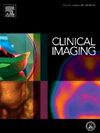与DXA相比,CT扫描对骨质疏松症的机会性筛查:一项系统回顾和荟萃分析
IF 1.8
4区 医学
Q3 RADIOLOGY, NUCLEAR MEDICINE & MEDICAL IMAGING
引用次数: 0
摘要
利用计算机断层扫描(CT)筛查其他适应症的机会性骨质疏松症的有效性尚未在现行指南中实施。我们的目的是收集与双x线吸收仪(DXA)相比,用CT扫描筛查骨质疏松症的有效性的现有证据。检索了2023年前发表的比较CT扫描与DXA诊断性能的研究。我们使用纽卡斯尔-渥太华量表对横断面研究进行了偏倚评估。与DXA相比,CT扫描的相关系数(CC)、曲线下面积(AUC)、敏感性和特异性采用随机效应建模进行meta分析。41项研究符合纳入/排除标准。纳入的研究报告了CT扫描的机会性骨质疏松筛查的弱至强CC(0.35至0.95)和低至高准确率。荟萃分析显示,中度合并CC为0.59 (95% CI: 0.53-0.64, p值<;0.001),相对较高的AUC为0.81 (95% CI: 0.78-0.84, p值<;0.001)。基于年龄和绝经状态的亚组分析没有显示组间的显著差异。与其他解剖区域相比,估计股骨近端CT扫描的准确度显着更高(CC: 0.70, 95% CI: 0.57-0.82;AUC: 0.79, 95% CI: 0.72-0.87),北美病例(CC: 0.66, 95% CI: 0.52-0.80;AUC: 0.82, 95% CI: 0.82 - 0.83),以及女性比例较高的人群(CC: 0.60, 95% CI: 0.52-0.69;Auc: 0.86, 95% ci: 0.83-0.89)。我们观察到,通过CT扫描获得的其他适应症的机会性骨质疏松症筛查表现中等。本文章由计算机程序翻译,如有差异,请以英文原文为准。
Opportunistic screening of osteoporosis by CT scan compared to DXA: A systematic review and meta-analysis
The efficacy of opportunistic osteoporosis screening with computed tomography (CT) scans obtained for other indications has not yet been implemented by the current guidelines. We aimed to compile available evidence on the efficacy of osteoporosis screening with CT scans obtained for other indications compared with dual X-ray absorptiometry (DXA).
Studies comparing the diagnostic performance of the CT scan with the DXA published before 2023 were retrieved. We conducted a bias assessment using the Newcastle-Ottawa Scale for cross-sectional studies. Correlation coefficients (CC), area under the curve (AUC), sensitivity, and specificity of the CT scans compared with the DXA were meta-analyzed with random effects modeling. 41 studies fulfilled the inclusion/exclusion criteria. The included studies reported weak to very strong CC (0.35 to 0.95) and low to high accuracy for opportunistic osteoporosis screening with CT scans. The meta-analysis showed a moderate pooled CC of 0.59 (95 % CI: 0.53–0.64, P-value<0.001), and a relatively high AUC of 0.81 (95 % CI: 0.78–0.84, P-value<0.001). Subgroup analysis based on age and menopausal status did not show significant between-group differences. Significantly higher accuracy measures were estimated for CT scans of the proximal femur compared to other anatomic regions (CC: 0.70, 95 % CI: 0.57–0.82; AUC: 0.79, 95 % CI: 0.72–0.87), North American cases (CC: 0.66, 95 % CI: 0.52–0.80; AUC: 0.82, 95 % CI: 0.82–0.83), and populations with a higher percentage of women (CC: 0.60, 95 % CI: 0.52–0.69; AUC: 0.86, 95 % CI: 0.83–0.89). We observed a moderate performance of opportunistic osteoporosis screening with CT scans obtained for other indications.
求助全文
通过发布文献求助,成功后即可免费获取论文全文。
去求助
来源期刊

Clinical Imaging
医学-核医学
CiteScore
4.60
自引率
0.00%
发文量
265
审稿时长
35 days
期刊介绍:
The mission of Clinical Imaging is to publish, in a timely manner, the very best radiology research from the United States and around the world with special attention to the impact of medical imaging on patient care. The journal''s publications cover all imaging modalities, radiology issues related to patients, policy and practice improvements, and clinically-oriented imaging physics and informatics. The journal is a valuable resource for practicing radiologists, radiologists-in-training and other clinicians with an interest in imaging. Papers are carefully peer-reviewed and selected by our experienced subject editors who are leading experts spanning the range of imaging sub-specialties, which include:
-Body Imaging-
Breast Imaging-
Cardiothoracic Imaging-
Imaging Physics and Informatics-
Molecular Imaging and Nuclear Medicine-
Musculoskeletal and Emergency Imaging-
Neuroradiology-
Practice, Policy & Education-
Pediatric Imaging-
Vascular and Interventional Radiology
 求助内容:
求助内容: 应助结果提醒方式:
应助结果提醒方式:


